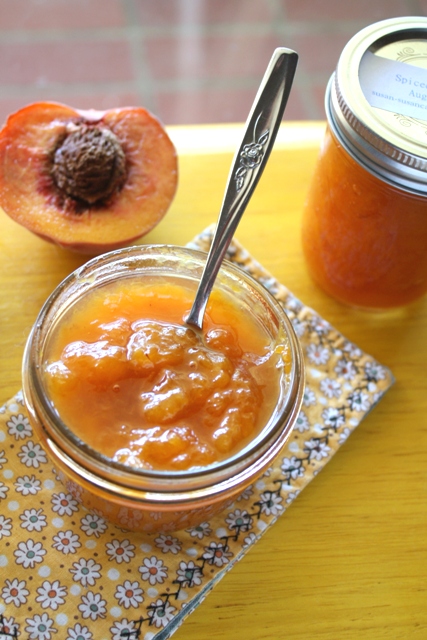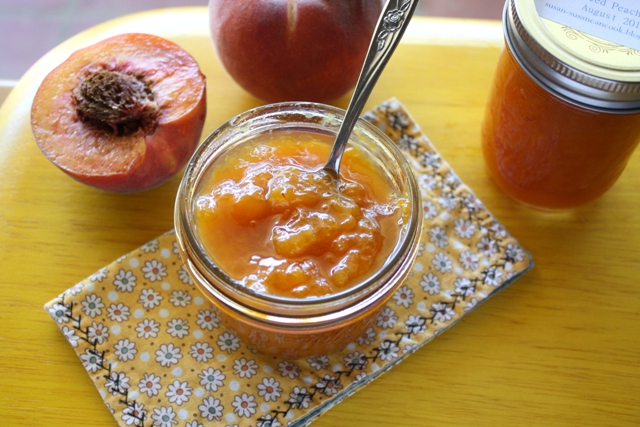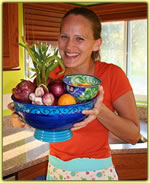I met Susan while giving a talk about food literacy at a women’s giving circle in Sacramento. I knew right away she was a kindred spirit. When she started talking about her amazing jams and her blog, I invited her to share a recipe. I hope you enjoy her inspired Spiced Peach Jam! Then, pop over and read her blog, Susan Can Cook. She sure can!
I’d like to thank Amber for inviting me to contribute to her fantastic site! I hope this will encourage you to try making some preserves of your own. Once you have the basics down and experience some success, you may never be satisfied with commercially produced jams again.
In August, the farmers’ markets begin to burst with stone fruits. I’ve seen (and enjoyed) some beautiful peaches, nectarines and plums this year. Sometimes you can smell their fragrance even before you see them. This particular batch of jam came from a friend’s little backyard orchard.
Once you start making jams, jellies and preserves, everyone you know who has a fruit tree will be glad to share with you for a portion of the finished product. Think about a single family eating a whole tree’s worth of fruit at its peak. This is why people preserve – to save some of the best of summer.
If you try this recipe, save a jar to open during one of those short, dark and wet winter days. Pop the lid, take a deep breath and spread a little summer on your toast.
Spiced Peach Jam Recipe
Ingredients:
About 4 pounds fresh peaches
¼ cup lemon juice (do not use Meyer lemons)
4 cups granulated sugar
2 cinnamon sticks
4 coins cut from fresh ginger – about ¼ inch thick
Farmers’ market ingredients: peaches
Grocery store ingredients: lemon juice, sugar, cinnamon, ginger
Instructions:
To prepare the peaches –
Place a large pot of water on the stove and bring to a boil. While waiting for the boil, cut an X in the bottom of each peach. The X should cover about 1 inch. Prepare an ice water bath by placing a couple of trays of ice cubes and a few cups of water in a large bowl on your counter top.
When the pot of water is boiling rapidly, gently drop a few peaches at a time into the boiling water. Let the peaches stay in the boiling water for exactly 1 minute. Remove the peaches from the boiling water with a slotted spoon and place them in the ice water bath. Start the next batch of peaches in the boiling water. As they do their one-minute, you can fish the first set of peaches out of the ice water bath and place on a baking sheet. I was able to do 6 peaches at a time in my big jam pot. After all the peaches have been boiled, cooled and placed on the baking sheet, slip the skins off. Do this process over the baking pan so no juices will be lost.
After the skins have all been removed, cut the peaches in half and remove the pit. Cut the peaches into about 1-inch chunks. When done, pour the peaches and the juice into a non-reactive container and stir in the lemon juice and sugar. Cover completely with plastic wrap that has been pressed down to make contact with the surface of the fruit. This will prevent the fruit from browning as it macerates.
If you wish, you can place the fruit in the fridge and overnight and do the canning the next day. If you plan to do it the same day, you can allow it to macerate at room temperature for a couple of hours. I often find it easier to prepare the fruit one night and can it the next.
Making the jam –
Place the fruit and all the juices into a large non-reactive pot. I use an 8-quart pot. Scrape any sugar that has not dissolved into the pan too. Add the cinnamon sticks and ginger coins. Place the jam on the stove and bring to a boil. Once it comes to a boil, reduce the heat slightly to prevent scorching. It should boil briskly, but it should not be a hard boil that cannot be stirred down. Use a potato masher to mash the peaches into smaller chunks. This will help with the thickening and help the fruit to be more evenly distributed.
As the jam boils, stir frequently and remove any excess foam with a flat metal spoon. When the jam starts to thicken, you can begin to test it for set. Do this by using a spoon pre-placed in the freezer to scoop a little of the jam out of the pot and place it back in the freezer on a saucer. Allow it to cool for about 2 minutes then take it out of the freezer and tip the spoon. If the jam runs right off, it is not ready. When it comes off in a sheet or a blob, use your finger to push what is now on the saucer. When it mounds up and wrinkles when you push it, it is ready.
Remove the jam from the heat. Skim any remaining foam. Stir the jam gently for a few minutes. Use tongs to remove the cinnamon and ginger. Carefully ladle the jam into the hot jars. Wipe the rims, top with the lids and rings and finger-tighten. When the jars are prepared, place in the boiling water bath and process gently for 10 minutes. Carefully remove the jars with your jar lifter, keeping the jars level, and place on a towel-lined tray. Allow them to sit, undisturbed until all the lids pop. You can wipe away any water at this point. Let the jars sit overnight before labeling and storage. Enjoy!




 Follow
Follow



{ 2 comments… read them below or add one }
Why not use meyer lemons, and please define non reactive pot.
Trish, Meyer lemons don’t have the same amount of acidity as other lemons, and for canning, acidity is critical to preserving for safety reasons. Here’s a great article on why a nonreactive pot is also important for canning: http://www.foodinjars.com/2010/09/canning-101-why-you-cant-cook-acidic-foods-in-reactive-pots/.